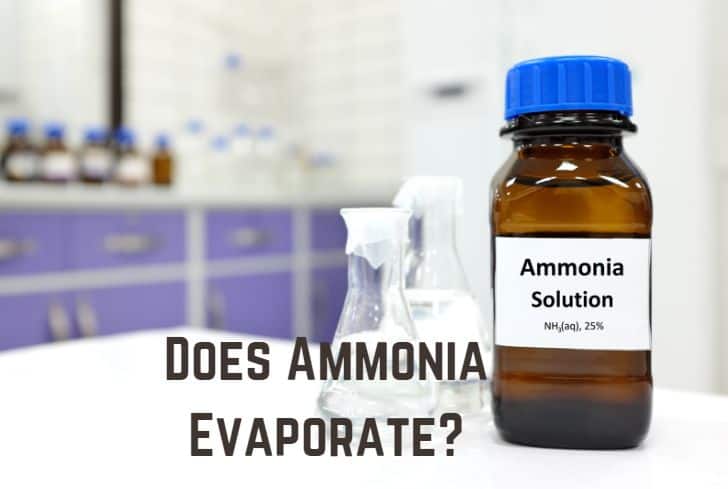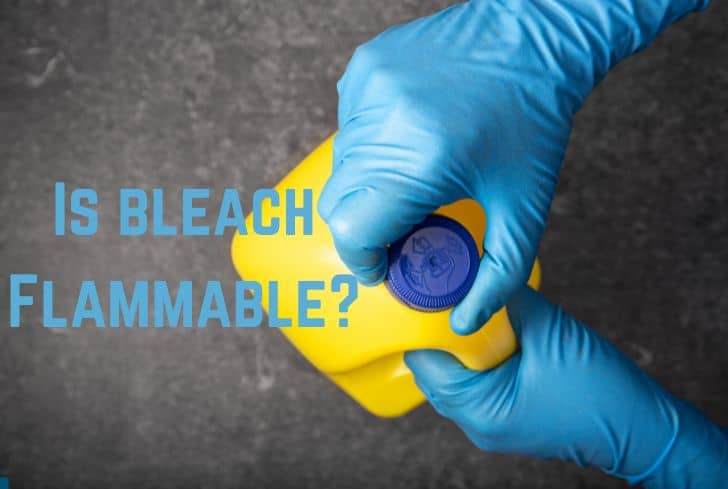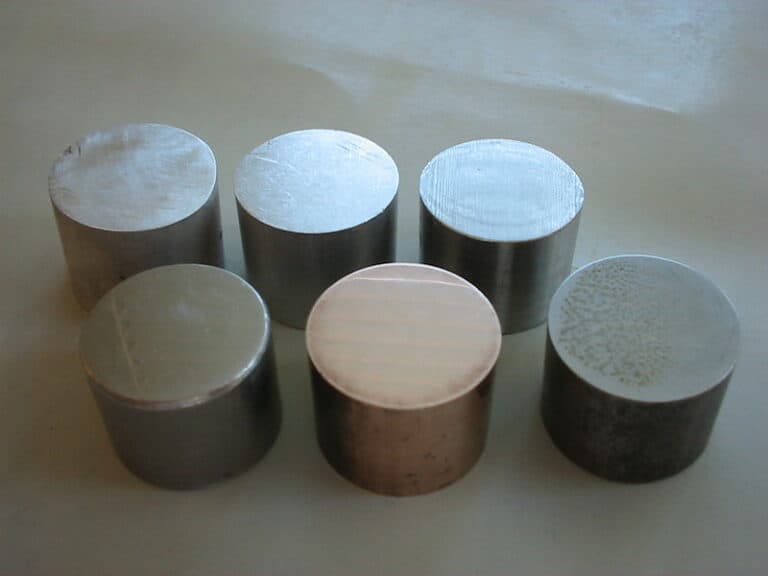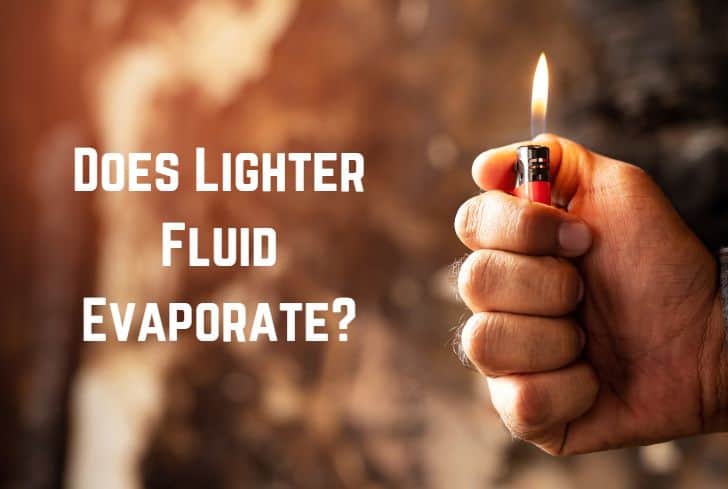Does Ammonia Evaporate? (Answered)

Most individuals use cleaning agents to keep their homes and workplaces tidy. But have you ever wondered what chemicals are in your household cleaning products? One of the main components is ammonia (ammonium hydroxide), usually known as household ammonia. But can you still see ammonia after cleaning? Does ammonia evaporate?
This article provides an answer to that question. Also, you will learn how fast and at what temperature ammonia evaporates and what happens. It will also be interesting to learn whether ammonia evaporates faster than water, dissolves in water, or conducts electricity. Would you like to know if ammonia smells in the air? Continue reading!
Read: Does Acetone Evaporate?
Does Ammonia Evaporate Completely?
Ammonia evaporates quickly and completely. It is a colorless gas and has a strong odor. It is known as ammonia gas or anhydrous “without water” ammonia when it is in a gaseous state. The chemical compound ammonia comprises one component, nitrogen (N), and three parts, hydrogen (H3). Ammonia gas, on the other hand, turns into a liquid under pressure when it is compressed.
Ammonia gas forms as liquid ammonia evaporate. It is this property that makes ammonia ideal in many industries. The gas is used to purify water supplies, as an ammonia-cleaning solution, and as a refrigerant gas. Ammonia is a component that manufacturers use to manufacture dyes, explosives, textiles, pesticides, and plastics.
What Happens When Ammonia Evaporates?
The evaporation of ammonia has the potential to produce a toxic cloud. The amount of ammonia that enters the atmosphere and the local weather will determine the size of the cloud. Ammonia in free flow is cold because it lingers in a thick cloud. Before evaporating into the atmosphere, the gas descends in a V-shape.
Ammonia absorbs a significant quantity of heat from its surroundings when it is used as a refrigerant gas and in air conditioning equipment. Avoid mixing ammonia with chlorine bleach as it produces toxic gases known as chloramines. When ammonia gas is exposed to the open air, it quickly transforms into liquid form.
If ammonia is kept in the open air, it quickly gets heated and becomes vapor. Nitrogen monoxide is hazardous to many species, and water vapor is created when the ammonia gas produced combines with oxygen.
4NH3+ 5O2 → 4NO + 6H2O
How Fast Does Ammonia Evaporate?
The purest form of ammonia, anhydrous ammonia, is lighter than air and will evaporate quickly. Ammonia grows heavier and does not evaporate as quickly under dampness. Ammonia evaporates more quickly in dry, windy conditions. The gas drifts with the wind until it fully evaporates. The airspeed affects how quickly ammonia evaporates at a specific temperature.
Evaporation rates are higher at higher air speeds. Yet, the evaporation rate is only high at the earlier stages but gradually decreases. The rate of evaporation reduces as the ammonia concentration does. The three stages of ammonia evaporation are highlighted below.
- Phase one: In this phase, the ammonia evaporation rate is high, which simultaneously affects the rate of heat transfer in the surroundings but also causes a drop in temperature. Ammonia concentration also begins to decrease.
- Phase two: The evaporation rate decreases due to the decreased temperature and reduced ammonia concentration.
- Phase three: The rate of ammonia evaporation keeps dropping in this last phase, and some water may begin to condense.
The conclusion of the three phases is a toxic ammonia cloud. If you notice a cloud of ammonia inside a room, stay away from it, as it’s cold and flammable. If you notice it outside, stay indoors and seal the windows and doorways. Shut off the heating and ventilation and wait until the cloud passes.
At What Temperature Does Ammonia Evaporate?
At any temperature higher than -28°F (-33°C). Ammonia in liquid form will become a gas at this temperature when exposed to air. Ammonia is a colorless, pungent smell that is extremely irritating at normal temperatures. It doesn’t take outside energy for evaporation to happen. It takes advantage of the liquid’s stored energy.
Heat energy is present in every liquid. Some molecules move quickly enough to escape into the air due to the heat. Evaporation is a natural process as a result. Several factors will influence the rate of evaporation.
- An increase in temperature also increases the rate of evaporation. Increasing kinetic energy causes the liquid to become vapor.
- The rate of evaporation depends on wind speed. When there is an increase in wind speed, the evaporation rate increases.
- The surface area of the liquid exposed determines the evaporation rate. The large the surface area, the faster the evaporation rate.
- The rate at which a liquid evaporates varies according to the humidity of the air around it. The air’s water vapor is referred to as humidity—the rate of evaporation increases with how dry the surrounding air is.
Does Ammonia Evaporate Faster Than Water?
Ammonia evaporates faster than water. Considering that water highly evaporates at temperatures over 212° F (100° C), while ammonia evaporates at temperatures above -28° F (-33° C). Since the average room temperature is between 68 to 77°F (20 to 25°C), ammonia evaporates below this range. At room temperature, water will begin to evaporate as well.
Nevertheless, as soon as the water reaches room temperature, it begins to evaporate. At room temperature, the evaporation rate is slower; however, it picks up speed at 212° F (100° C). The molecules leave the liquid during evaporation and join the air. Evaporation only happens on the liquid’s surface.
Does Ammonia Dissolve in Water?
Ammonia dissolves readily in water. At standard pressure and temperature, anhydrous ammonia, with the chemical formula (NH3), exists as a gas. About 50 grams of the gas dissolves in 100 milliliters of water. Ammonia water, aqueous ammonia, ammonia solution, and ammonium hydroxide are all names for their water-based solutions (NH4OH). Be aware that this mixture is very toxic.
Most ammonia transforms into ammonium ions, an ionic form of water when it is in contact with water. The ions are not gaseous and have no odor. Ammonia’s high solubility in water is due to the hydrogen bonding and the attraction between ammonia and water molecules. Water and ammonia mix to form ammonium hydroxide, a caustic solution and a weak base.
Liquid ammonia is created by dissolving ammonia gas in water, which is then used to create household and commercial cleaning solutions. Higher concentrations of ammonia, up to 25%, are present in industrial cleaning solutions. Ammonia concentrations in household cleaners range from 5 to 10%.
Does Ammonia Conduct Electricity?
Ammonia does not conduct electricity in its gaseous form due to insufficient ions. The aqueous solution of ammonia( ammonium hydroxide) conducts electricity because it has ions in its solution state. Solution ions conduct electricity. It is a weak electrolyte because weak electrolytes in solutions incompletely break down to form ions.
Ions are particles that move through a solution carrying an electrical charge. Atoms or tiny atoms with an electric charge are known as ions. Ions can either be positive or negative charges. Pure water does not transmit electricity and contains extremely few ions. You might be surprised to learn that, although not very well, ammonia laundry conducts electricity.
Ammonia reacts with water and creates ions when it dissolves in liquid. However, a water and ammonia mixture produces very few ions and possesses poor electrical conductivity. The opposite occurs when ammonia and vinegar are mixed. Ammonia and the acetic acid in vinegar react, creating many ions. When mixed, ammonia and vinegar readily conduct electricity.
Can You Smell Ammonia in the Air?
It is possible to smell ammonia in the air. Given that it can develop naturally due to decomposition, the gas has an irritating and corrosive odor. You’ll feel an acute burning in your throat, nose, and respiratory system when you inhale high concentrations of ammonia. You might experience coughing and throat and nose irritation at lower concentrations.
Due to its choking smell, it’s easy to detect. However, when you smell it for a prolonged period in low concentrations, the level of awareness drops. It’s important to note that children tend to smell ammonia more due to their shorter height, which makes them close to ground levels.
It is simple to detect because of its suffocating smell. Yet, the sensitivity decreases as you smell it repeatedly in small doses. As a result of their shorter stature and proximity to the ground, children are more likely to smell ammonia than adults.
Small quantities of ammonia can be harmful to persons who have asthma or are allergic to it. You could be exposed to greater ammonia levels when exposed to leaks and spills from pipelines, tank trucks, and ships transporting ammonia. Ammonia-containing household items could expose you to the gas indoors.
Read: Does Vinegar Evaporate?
Conclusion
Ammonia is a gas; thus, it evaporates fast and completely. Ammonia’s liquid state vaporizes to become a gas. Nevertheless, ammonia evaporates and forms a hazardous ammonia cloud. Ammonia absorbs heat from the surroundings when it evaporates.
Ammonia evaporates at a rate influenced by temperature, humidity, wind speed, and surface. Ammonia does not conduct electricity when it is gaseous since there aren’t any free ions. Nevertheless, ammonia reacts to release ions that conduct electricity when it comes into contact with water or vinegar.






